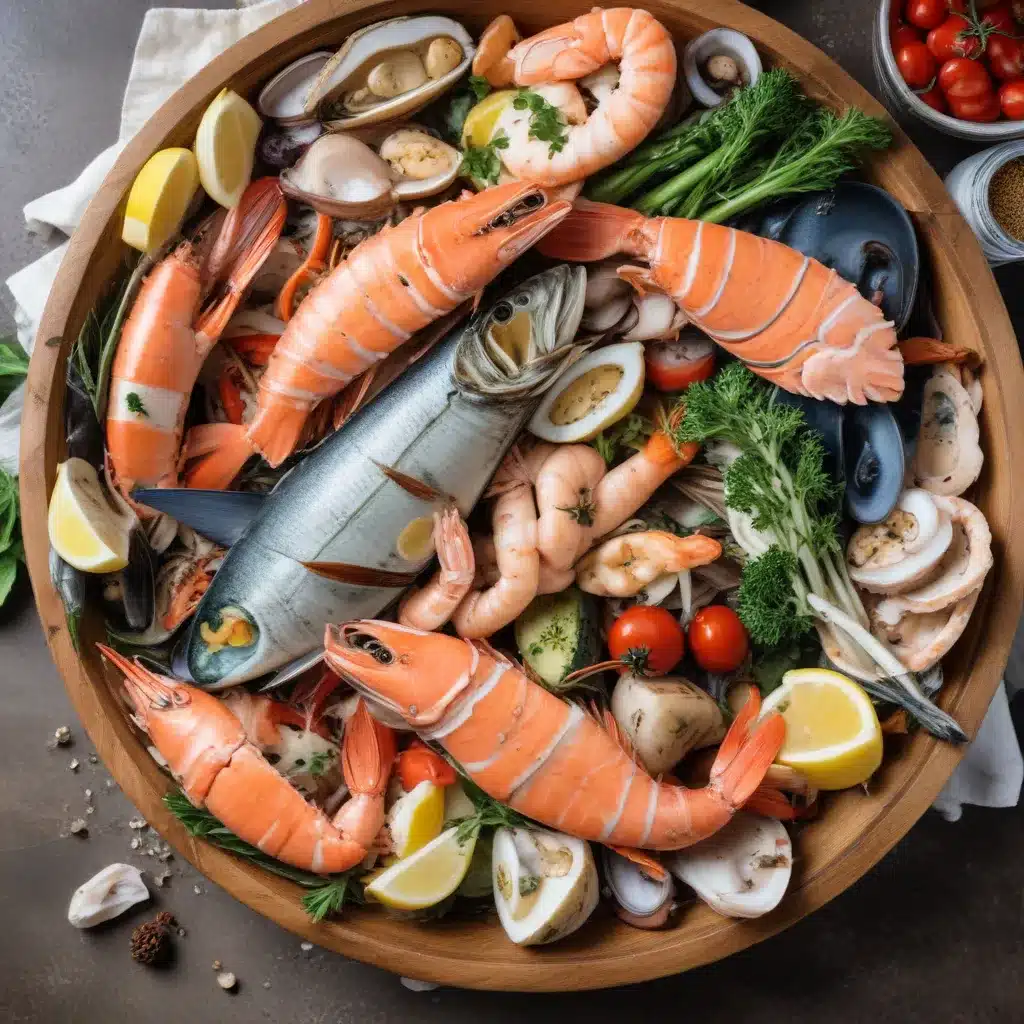
The ocean’s depths hold an abundance of nutritional treasures, each species offering a unique profile of macro- and micronutrients. As a seafood dining expert writing for Fish Tales Cafe, I’m excited to dive into the intricacies of these aquatic delicacies and share insights on how to maximize their benefits.
The Nutritional Richness of Seafood
At the heart of seafood’s nutritional prowess lie the macronutrients – protein, fat, and carbohydrates. Finfish, such as cod, boast high-quality protein, with an impressive amino acid composition that supports muscle growth and maintenance. Moreover, many seafood varieties are remarkably low in carbohydrates, making them an ideal choice for those following keto or paleo diets.
The true standout, however, is the abundance of healthy fats found in seafood, particularly the omega-3 fatty acids eicosapentaenoic acid (EPA) and docosahexaenoic acid (DHA). These compounds have been extensively researched for their cardiovascular benefits, anti-inflammatory properties, and crucial role in brain and eye development.
Seafood also shines when it comes to micronutrients. Finfish, shellfish, and crustaceans are rich in vitamins and minerals, including vitamin D, B-complex vitamins, selenium, zinc, and iodine – all of which play vital roles in immune function, metabolism, and overall well-being.
Sustainable Seafood Sourcing
As we navigate the world of seafood, it’s crucial to consider the sustainability of our choices. The distinction between wild-caught and farmed seafood is an important one, as each has its own environmental implications.
Wild-caught seafood, when sourced responsibly, can be an exemplar of sustainability. Fisheries that employ eco-friendly practices, such as line fishing and gill netting, help preserve marine ecosystems and ensure the long-term availability of these precious resources. On the other hand, poorly managed aquaculture operations can lead to issues like habitat destruction, pollution, and overfishing of wild stocks.
Fortunately, there are numerous certification programs and traceability initiatives that empower consumers to make informed decisions. By purchasing seafood with reputable eco-labels, you can support fisheries and farms that prioritize environmental stewardship and ethical practices.
Seafood Variety and Benefits
The culinary world of seafood is vast and diverse, each species offering a unique set of nutritional benefits. Finfish, such as cod, salmon, and tuna, are versatile staples that can be prepared in countless ways, from pan-searing to oven-roasting to en papillote.
Shellfish, including oysters, mussels, and clams, are nutritional powerhouses, packed with essential minerals like zinc, copper, and selenium. These delicacies can be enjoyed raw, steamed, or incorporated into creative dishes like cioppino or bouillabaisse.
Crustaceans, such as shrimp, lobster, and crab, are prized for their succulent textures and flavor profiles. Whether grilled, sautéed, or baked, these seafood treasures deliver a protein-rich punch that can elevate any meal.
Seafood and Dietary Needs
Seafood’s nutritional prowess extends beyond just macronutrients and vitamins. The omega-3 fatty acids found in many varieties have been linked to a host of health benefits, including improved cardiovascular function, cognitive performance, and immune system support.
For individuals seeking to optimize their heart health, regularly incorporating oily fish like salmon, mackerel, and sardines into the diet can help lower triglyceride levels and reduce the risk of coronary heart disease. Likewise, the DHA and EPA in seafood play crucial roles in brain development and neurological function, making it an essential component of a balanced diet.
Preparation and Cooking Techniques
Preserving the nutritional integrity of seafood is paramount, and the way it is prepared can make all the difference. Gentle cooking methods, such as poaching, steaming, and en papillote, help retain the delicate flavors and delicate textures of these aquatic delicacies.
For a flavor-packed experience, pan-searing, grilling, or baking seafood can unlock a world of culinary possibilities. By employing techniques like brining, marinating, or sauce-making, you can enhance the natural umami notes and create truly memorable dishes.
Addressing Seafood Allergies and Sensitivities
While seafood is a nutritional powerhouse, it’s important to acknowledge that some individuals may have allergies or sensitivities to certain varieties. Proper identification and management of these conditions are crucial to ensuring a safe and enjoyable seafood experience.
For those with seafood allergies, effective strategies may include avoiding the specific allergen, carefully reading ingredient lists, and discussing safe substitution options with healthcare professionals. In the kitchen, thoughtful preparation techniques, such as thoroughly cleaning surfaces and using dedicated utensils, can help mitigate the risk of cross-contamination.
Seafood and Specialized Diets
The versatility of seafood extends beyond its nutritional benefits, as it can seamlessly integrate into a variety of specialized dietary patterns. For vegetarians and vegans, plant-based seafood alternatives, such as seaweed, kelp, and algae, offer a sustainable and flavorful way to incorporate the unique flavors and textures of the sea.
Those following paleo or keto lifestyles can find ample seafood options that align with their dietary guidelines. Fatty fish, shellfish, and crustaceans are all low-carb, high-protein choices that can be easily incorporated into a wide range of recipes.
Sustainable Seafood Certification and Labels
As consumers, we hold the power to shape the future of our oceans through our purchasing decisions. By seeking out seafood with reputable eco-labels and certification programs, we can support fisheries and aquaculture operations that prioritize sustainability, transparency, and ethical practices.
Organizations like the Marine Stewardship Council (MSC), Aquaculture Stewardship Council (ASC), and Monterey Bay Aquarium’s Seafood Watch program offer valuable guidance in identifying seafood that aligns with our values and environmental concerns. By making informed choices, we can ensure that the bounty of the sea remains bountiful for generations to come.
Exploring the depths of seafood’s nutritional riches is a journey worth embarking on. Whether you’re a seasoned seafood enthusiast or just beginning to discover the wonders of the ocean’s culinary gems, this comprehensive guide aims to equip you with the knowledge and confidence to navigate the vast and delicious world of seafood. So, dive in, savor the flavors, and experience the unparalleled benefits that this aquatic bounty has to offer. For more seafood inspiration and recipes, be sure to visit Fish Tales Cafe at https://www.fishtalescafe.com.

